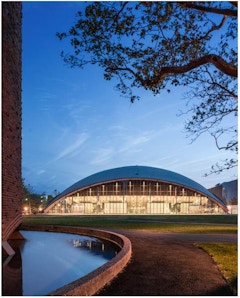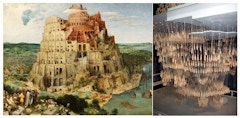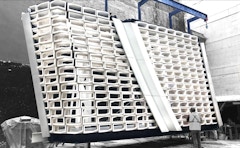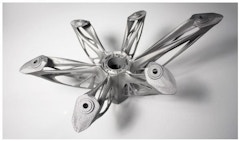
32 results
-
 Highly transformable materials can be used as adaptive exterior shading systems by leveraging the relationship between external stimuli (heat) and…
Highly transformable materials can be used as adaptive exterior shading systems by leveraging the relationship between external stimuli (heat) and… -
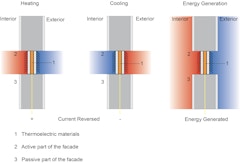
Novel Active Facade Systems and Their Energy Performance in Commercial Buildings
- Paper by Ajla Aksamija · Mahsa Farid Mohajer · Zlatan Aksamija
This article presents results of a research study that focuses on understanding energy performance of novel facade systems that integrate
-

Thermoelectric Facades
- Paper by Ajla Aksamija, PhD, LEED AP BD+C, CDT · Zlatan Aksamija, PhD · Mahsa Farid Mohajer · Meenakshi Upadhyaya · Guy Vigneau
This article discusses design, prototype development and a simulation study of novel types of facade systems, which integrate thermoelectric (TE)
-

Adaptive Facades
- Paper by Walter Haase, Werner Sobek, Enrica Oliva, Michele Andaloro,
Facade engineering aims at appropriately balancing the demands imposed by the context and the capabilities inherent to the materials, the geometries… -
Localized Rigidification of PCM Envelopes
- Paper by Elnaz Tafrihi
This is an experimental and computational exploration of structural systems that transform between states of rigidity and flexibility. The goal is to
-
Renewing Two Saarinen Icons
- Paper by David N. Fixler, FAIA · Gary Tondorf-Dick, AIA, LEED AP · Katherine S. Wissink, PE · Matthew B. Bronski, PE
Kresge Auditorium and the MIT Chapel, designed by Eero Saarinen and built in 1955, are both world renowned works of architecture and powerful symbols
-

Retroreflective Coating for Window Blinds
- Paper by Luca Papaiz · Lars Oliver Grobe · Giuseppe De Michele
Solar shading devices are required to find a trade-off between conflicting requirements: Protection from excessive solar gains and glare, daylight
-
Fit for the Future
- Paper by Julia Koerner-Al-Rawi, Associate Adjunct Professor, Director of Summer Programs, Department of Architecture and Urban Design
Wearables protect us from climatic conditions, they provide privacy, comfort and they also reflect our style and personality. Building facades in the… -
Digital Medium, Tangible Message
- Paper by Nathaniel Barlam
The reaches of architecture are inherently linked to the efficacy of communication, and as emerging technology broadens the conceptual horizon of the
-

Iconic Buildings
- Paper by Xavier Ferrés Padró · Paula Martín Goñi
The iconic building principal incentive is to be visually attractive or stand out, for this purpose three main features must be accomplished: have a
-
Growing Myceliated Facades
- Paper by Thibaut Houette, M. Arch. · Brian Foresi · Christopher Maurer, AIA, NCARB · Dr. Petra Gruber
Today's sustainability in architecture takes into consideration the complete life cycle of buildings and their components, from resource harvesting
-

Shaping Skin
- Paper by John Neary AIA LEED AP NCARB, Sr. Associate
The conventional modern facade is essentially flat, which creates the tendency toward visual monotony and problems for modulating daylight—both on… -

Contextual Envelopes
- Paper by Zoltan Neville,
Aesthetic and technical capabilities of facade design have become seemingly endless as building technologies progress. While the capacity to address… -

Facade Technology in Educational Methodology
- Paper by Roger Schroeder · Joseph A. Ebert
With facades becoming increasingly more complex, and performance a key objective, expertise becomes an important component of successful design
-

Pioneering the Structural Terracotta Mullion Façade
- Paper by Victoria Ereskina · John Neary
Architects today must explore alternative enclosure materials to meet evolving energy codes and embodied carbon regulations. Terra cotta has been
-
Reinforced Polymer Concrete Screen Walls
- Paper by Brock DeSmit · Jessica Hong · Becher Eli Neme
Apertures is a six-story, commercial building in the Roma Norte neighborhood of Mexico City–a neighborhood severely impacted by the 1985 and 2017
-

The Butterfly
- Paper by Venelin Kokalov · Shinobu Homma, Architect AIBC, AAA, MRAIC · Amirali Javidan · Zhuoli Yang, AIA, NCARB, LEED AP BD+C
Providing a unique and integral cladding/envelope solution suited for high-rise buildings has been an inherent challenge for this building typology
-

Prefab Facades – from Prototype to Product?
- Paper by Lisa Rammig · Andrea Zani · Tim Murphy
Building envelopes are not only an immediately visible part of the building, they have also become a major factor both for cost and performance of
-
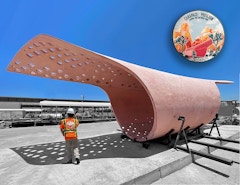
The Carapace Pavilion
- Paper by Douglas Noble, PhD, FAIA · Karen M. Kensek, DPACSA
The Carapace Pavilion is a university-based, design-build, full-scale custom prototype for a possible replacement of the standard precast concrete
-
Differentiated Building Skin
- Paper by James Warton
The Los Angeles Stadium’s doubly curved skin is composed of over 35,000 unique triangular panels covering 296,502 square feet of surface area. The

